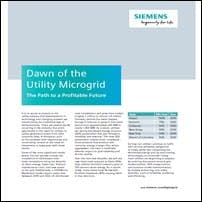Advanced Microgrid Controls: To Be or Not To Be – The Key Considerations to Help You Decide
Siemens Digital Grid’s Clark Wiedetz walks readers through through the question of whether to operate your microgrid using advanced microgrid controls that are centralized or simpler decentralized controls.
Clark Wiedetz, director of microgrids and renewable integration, Siemens Digital Grid
I recently attended the fourth annual Microgrid Conference in San Diego, hosted by Microgrid Knowledge. With more than 400 attendees, the conference has grown in attendance by 10-fold since its inception, which is indicative of the growth of the microgrid market as a whole. For instance, the global microgrid market is estimated to be valued at $30 billion by 2022, growing at a compound annual growth rate (CAGR) of 15% between 2018 and 2022, according to GlobalData. The total U.S. installed microgrid capacity is expected to reach nearly 9 gigawatts by 2024, according to WoodMac’s most recent microgrid forecast. To put things in perspective, 9 gigawatts of power is equivalent to 28.125 million PV panels or 11.7 million horses or 18,000 Corvette Z06s, as per the U.S. Department of Energy’s website.
As microgrid deployments continue to rise, the question of whether to operate your microgrid using advanced centralized controls or simpler decentralized controls also arises. This question was quite apparent to me in San Diego at Microgrid 2019. Hence, I decided to put together some key considerations to help you decide whether advanced microgrid controls make sense for your deployment.
- What are the main capabilities that you require? If the main capabilities include islanding, blackstart, resynchronization, and/or load shedding/restoration, then an advanced microgrid controller might be right for you. My first example is a leader in the mining industry for supplying quality aggregate and concrete since the 1970s. Last year due to repeated power interruptions, they decided to look at a microgrid to eliminate or reduce those issues and give themselves the ability to island from the grid during longer interruptions. Ultimately, this company decided to add an advanced microgrid controller to command and dispatch solar PV, battery storage and a gas generator.
- What is your asset mix? If you need to control more than two of the following types of assets, then an advanced microgrid controller might be right for you – solar PV, wind turbine, battery storage system, diesel generator, CHP, and/or hydro power. My second example is a major U.S. port that will incorporate a 1 MW solar PV array, an onshore 2.6 MWh battery storage system and associated electrical infrastructure. Notable features of the project include heavy duty electric drayage trucks, yard tractors and high-power EV chargers. As a result, it made sense for the port to deploy advanced microgrid controls.
- How big is your load size? If your minimum output is more than 250 kW, then an advanced microgrid controller might be right for you. My third example is a medical center that added some backup power capacity by installing a new 725 kW CHP system. In addition to enhancing the resiliency for its critical infrastructure, the advanced microgrid controller will enable the medical center to maximize the use and return on investment of its new CHP and other backup generation assets.
Innovators, developers, utilities, technology and engineering firms, investors, policymakers, regulators and advocates had all gathered in San Diego to help shape/redefine the new electric grid. It was apparent from the conference that microgrids will be at the heart of this reshaping. Hopefully this article can serve as a guide to help you determine if advanced microgrid controls make sense for your microgrid deployment.
Clark Wiedetz is the director of microgrids and renewable integration at Siemens Digital Grid.
Download this report.
Download the newest white paper from Siemens and learn more about how today’s utilities are beginning to prepare by entering discussions around grid modernization, the utility microgrid, DER compensation, and business model transformation, by sharply enhancing core utility priorities, such as reliability, resiliency, and efficiency.

